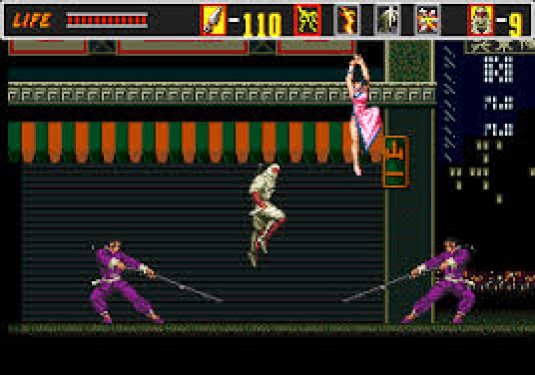
Published in Japan in 1989, Revenge was designed to be a showy number for the new machine - a task the programming team acquitted with aplomb. For an early game, it says something that by the end of the MegaDrive's run this was still one of the better-looking, best-playing action platformers available. And this is before mentioning the soundtrack composed by Yuzo Koshiro, which automatically places it in the top tier of 16-bit game music. I can still remember first clapping eyes on the game when my mate got it on import not long after release. Revenge was head and shoulders above anything else I'd seen in the home at that time, and certainly made my humble Speccy that wee bit more humble. Everything about it oozed a polish rare in British computer games - no wonder it was about £40 (when it was officially released in Europe in 1990, it usually weighed in at £34.99).
The plot is pretty straight forward. You are Joe Mushashi, Shinobi ninja master extraordinaire. After your exploits in the previous game (Shinobi, funnily enough), the evil crime syndicate Neo Zeed have slaughtered your dojo and kidnapped Naoko, your bride-to-be. Terrible. There follows eight stages of shuriken throwing, sword slicing, platform jumping, boss-slaying action. Joe is equipped with an energy bar, so no annoying one hit kills, and a few special abilities. There is a double jump feature that sees you somersault which, in turn, allows you to throw a fanning pattern of shurikens simultaneously. Especially useful for blind jumps, of which there are a few, and taking out the first end-of-level bad 'un. The second is jolly old ninja magic, because no self-respecting warrior of stealth would leave home without it. These come in four flavours - an invincibility shield, a high jump ability, columns of roaring flame that deal damage to enemies, and, um, a spell that causes your body to explode. Very good for quickly dealing with bad ass bosses, but a life is lost each time it's cast. Unsurprisingly.
Revenge then is uncomplicated fun. Kill enemies, find your way through each mini stage, beat the boss. And the boss cast are an interesting mix. Stage one has a giant samurai, two a shuriken flinging disco ninja (yes, really), three a brain in a jar, five a missile launcher, and lastly Zeed himself - a portly Kabuki-type who attacks with a lethal wig. The bosses I failed to mention are, um, not entirely original. Level four has you going up against an Arnie look-a-like who turns out to be a terminator. Level six is Spider-Man(!) who, in the first pressings of the game, morphed into Batman(!) after a set number of hits. And level seven finds literal Godzilla as your playmate, which was reskinned as a skeleton-and-innards monstrosity in subsequent versions of the game. There are other naughty touches too, like flame throwing Rambo doppelgängers (called Rocky, funnily enough), baddies resembling Jackie Chan, and an intro nicked from an old ninja movie. Lots of lovely little "borrowings" the copyright police did not appreciate.
We've talked many times about crime and criminals being the ideal foil for video games. Early on in gaming, baddies had to be unproblematically bad, which meant aliens, robots, soldiers, and henchmen. But where these are taken on by Joe are quite varied, for the time. Cityscapes are naturally included, but there's a pretty waterfall level, a military base, some sort of aeroplane, the top of a speeding train, a highway replete with dangerous joyriders, a factory, dockyard, munitions plant, and a maddening maze sure to have upset hundreds of thousands of gamers over the years. The scene setting does a good job of suggesting travel across Japan and then into the US. As such, the references and tropes draw deep from Japanese perceptions of American culture and, in turn, the Western perception of Japan in the late 80s: technologically advanced but steeped in martial arts and mysticism. The cultural mix is executed brilliantly, and extends to Yuzo Koshiro's soundtrack with a seamless blend of Japanese traditionalism and Western dance music - which he was later to perfect. Chinatown is my personal highlight.
Yet, as per most games well into the 1990s, the most modern medium was organised around the horribly dated damsel-in-distress theme, though it later turns out your toughest conventional enemies are dagger wielding nuns and sword swinging women. Also, while it is a Japanese product for Western audiences it does reinforce orientalist notions of Eastern exotica while also contributing in a very small way to the (overly American) anxiety about Japan's technological superiority and economic domination. The fact Neo Zeed HQ is located in NYC and has drawn American icons into his insidious bidding - some of whom are clearly US soldiers too - crystallises these inchoate concerns perfectly. Though in reality, what Revenge was was a killer app for a machine determined to wrest US market share from an already-dominant Japanese company. Perhaps Joe's Sega was coming to save America from Zeed's Nintendo?
Revenge then is an excellent game, one that offers an all-round solid and satisfying experience in 2020, both for those who want a decent 16-bit challenge and others who might like unfurling the 80s tropes and trends crammed into its four megabit cartridge.
Image Credit
No comments:
Post a Comment
Comments are under moderation.